
It allows to keep PV going, with more focus towards AI, but keeping be one of the few truly independent places.
-
I agree with Subco, you see less jello because you have less lines if resolution in the image.. realize in Full frame you have far more lines coming from the sensor in the image and in extra tele you have just 1080 or 720 lines in the image.. the read speed of the sensor may indeed be the same but your only seeing a percentage of those lines refreshing.. less delay from the top to the bottom of the frame in extra tele.. lets say it takes 1 second to scan the entire sensor from top to bottom.. well then the Extra tele portion would only take about 1/2 a second to go from top to bottom.. but the sensor didn't change its reading speed, you just only saw a portion of it. so your sensor is still readingt he same speed, its just that your portion from top to bottom goes by faster..
This is the same reason for the added noise and banding I assume.. its like zooming in on a LCD screen or projected DLP image etc, wide it looks like a big smooth image... the closer your view gets, you start to see the screen door and structure of how the image is composed. In full frame your reading a 4k X 3k pixel sensor then mashing it all together and getting a average of the pixels in a general area of the sensor, in extra tele your seeing 1:1 pixel information in your recording.. no averaging with neighboring pixels.
-
The distortion caused by a rolling shutter is linear as long as the motion is all at a constant rate. For example if you shake the entire camera then a static scene will move in unison and the distortion will all be linear.
If the subjects in the frame all move in the same direction and at the same speed then the rolling shutter distortion will be linear and equal for all of those subjects as well.
Reading less of the frame has no affect on the rolling shutter unless it also means that your sensor readout speed gets faster. That does not appear to happen with the GH2.
-
Is this just an impression? (Like a full moon looks bigger on the horizon, ie an optical illusion?) If so, it's no less valid! But @mpgxsvcd has posted video where the jello can be measured, in pause mode, as an off-vertical angle.
If anyone can post individual frame stills demonstrating any difference, please do so.
-
I look at the degree to which vertical lines are skewed for a given speed of horizontal motion across the frame. (speed relative to the frame, i.e., frame widths per second - independent of the lens or the scene) There is less skew in ETC mode. I don't need to measure it. It's there, easily observable and consistent, both in mpgxsvcd's test and my own tests. If someone wants to measure it and get a number, go nuts.
-
Discussions like this remind me of when everybody still believed the coriolis effect could be observed in a hand basin. Some would agree to try watching water go down the plughole just a few times to see which way it revolved. They would be surprised to see it changed direction randomly. Others would be prepared to argue black and blue that it changed direction only when you changed hemispheres!
As an Aussie living in France I grew tired of these discussions. For a while I made a few francs winning all the bets. Then I felt like I was getting as pedantic as the coriolis-loonies. The party-pooper. The guy who tells kids there's no Santa.
Honestly, this site is named personal-view, and views are appreciated. But hey, we've got the GH2s, the computers and the brains. How about more of these great tests people are doing? It's called "lifting a finger." Talk is only cheap when testing is cheap too.
"When the Facts Change, I Change My Mind. What do you do, Sir?" (John Maynard Keynes, economist)
-
There's a well known psychology experiment (we've probably all heard of it) where an unsuspecting volunteer is asked to identify which chalk line on a chalkboard is the longest. When everybody else votes for the second-longest, so does the unsuspecting volunteer. Often the volunteer is afraid to speak up, often the volunteer sees what the others do.
When scientists recently added red food dye to white wine, professional wine tasters described the red wine as "woody," "tobacco." But when given the same white wine without dye, they wrote, "clean,"refreshing", etc.
We're all susceptible to errors of judgement -like when we're with others we have confidence in.
Now I am starting to believe people do perceive the jello. And I believe that matters. Because film making is all about perception. For example, we can perceive human faces extremely well: "..the speed with which an emotion unfolds has been found to affect the perception of the expression (Kamachi et al., 2001). Given the fleeting nature of facial expressions, these differences in expression dynamics take place within a matter of milliseconds". http://scholar.google.com.au/scholar_url?hl=en&q=http://www.affective-sciences.org/system/files/biblio/Krumhuber%2520et%2520al%2520Emotion%25202007.pdf&sa=X&scisig=AAGBfm13OpjL8kkWmghpD7Dfe33H4u3L_Q&oi=scholarr&ei=6SmiT8v6BOGtiAfyyuDtCA&ved=0CBoQgAMoADAA
But the jello test is easy. When I have finished setting up my gear here I'll post some shots of a spinning barrel.
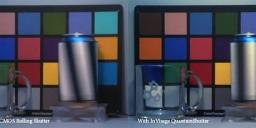
 inVisage-550x205.jpg550 x 205 - 71K
inVisage-550x205.jpg550 x 205 - 71K -
Let's see some samples then. I would be perfectly happy to be wrong. I just need to see some scientific evidence in order for me to believe it. I agree with Roberto that perception could trump actual measurable results. However, I haven't seen any samples that support that perception is any different.
I will try to do some more testing again today. I will try with a static subject and a moving camera and post samples for all resolutions and all frame rates. That might take a little more time to do though.
-
Skew and jello are the same thing.
Well definitions vary. But skew is accepted as being reasonably uniform whereas when video "goes crazy" we seem to refer to it as "jello" or "wobble."
I think skew can be reliably measured by using a spinning barrel (or traffic!). To produce jello, some predictable change in direction might be helpful, perhaps a mechanical metronome.
-
Hello, Interesting and valid discussion here. Thanks. Has anyone tried after effects plug-ins that are designed to reduce rolling shutter effect? It seems like a monumental task of computing. Especially after looking at those trucks rolling by. Also, makes me what to stay off that highway in my tiny car. Cheers
-
OK so no one else appears to want to test this. I guess I will have to just do all the work. I tested on 720p and 1080p @ 24 FPS some more.
At normal 24 FPS shutter speeds(1/50th) the image is simply too blurry to tell anything. With and Without ETC look the same and they both look bad. With 720p I couldn't tell a difference at all.
However, with a 1/4000th shutter speed, 24 FPS, and ETC the angle did appear to change. Now we are not talking about a huge difference here. I will leave it up to someone else to actually measure the angle difference. The still images from the videos are below.
That being said I really don't think the difference in with or without ETC is perceptible in normal shooting scenarios. Remember these trucks are whizzing by at 70 mph less than 200 feet from me and I am shooting at a 35mm equivalent of 280mm.
If you are filming in those conditions then jello is not what ruined your shot. Your choice of settings and lenses is what ruined the shot.
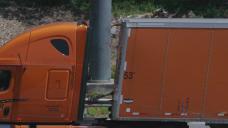
 ETC.JPG1861 x 1047 - 1M
ETC.JPG1861 x 1047 - 1M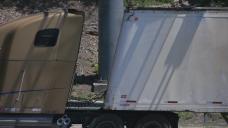
 No ETC.JPG1861 x 1047 - 1M
No ETC.JPG1861 x 1047 - 1M -
OK, I've just processed grabs of each of @mpgxsvcd 's truck shots here. I tried to get the angles of skew right using a drawing program - you'll get the idea...
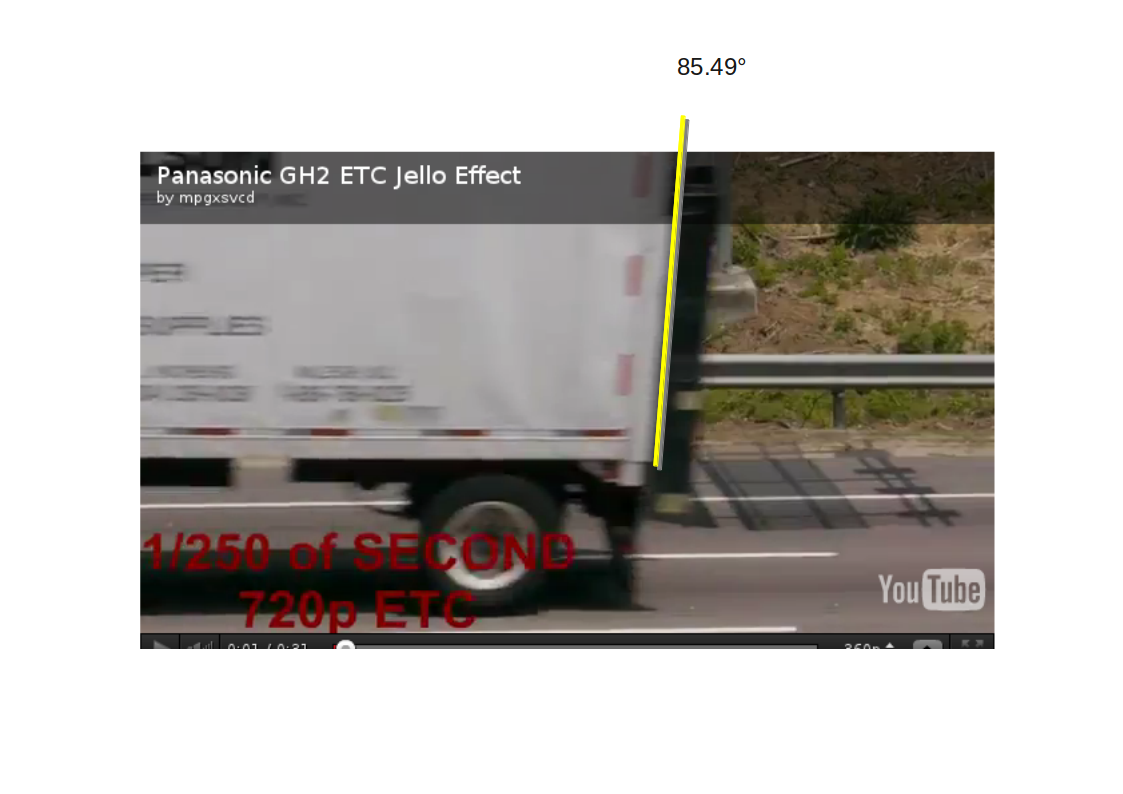
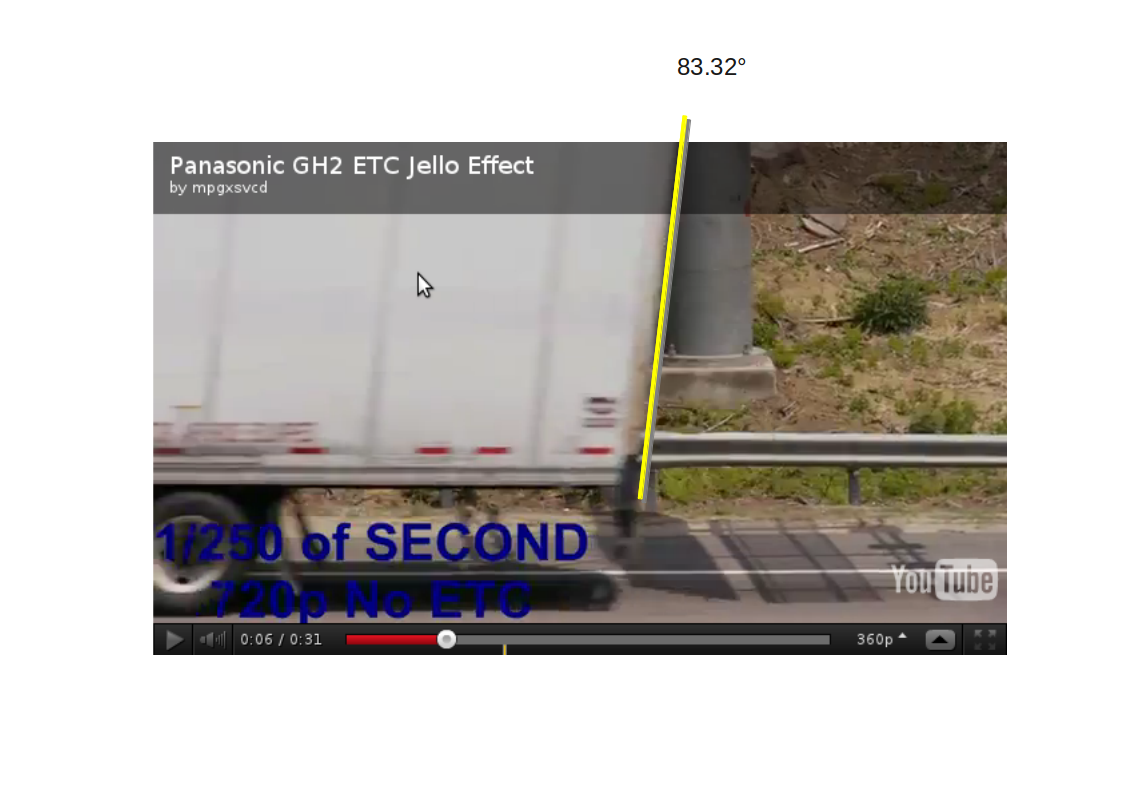
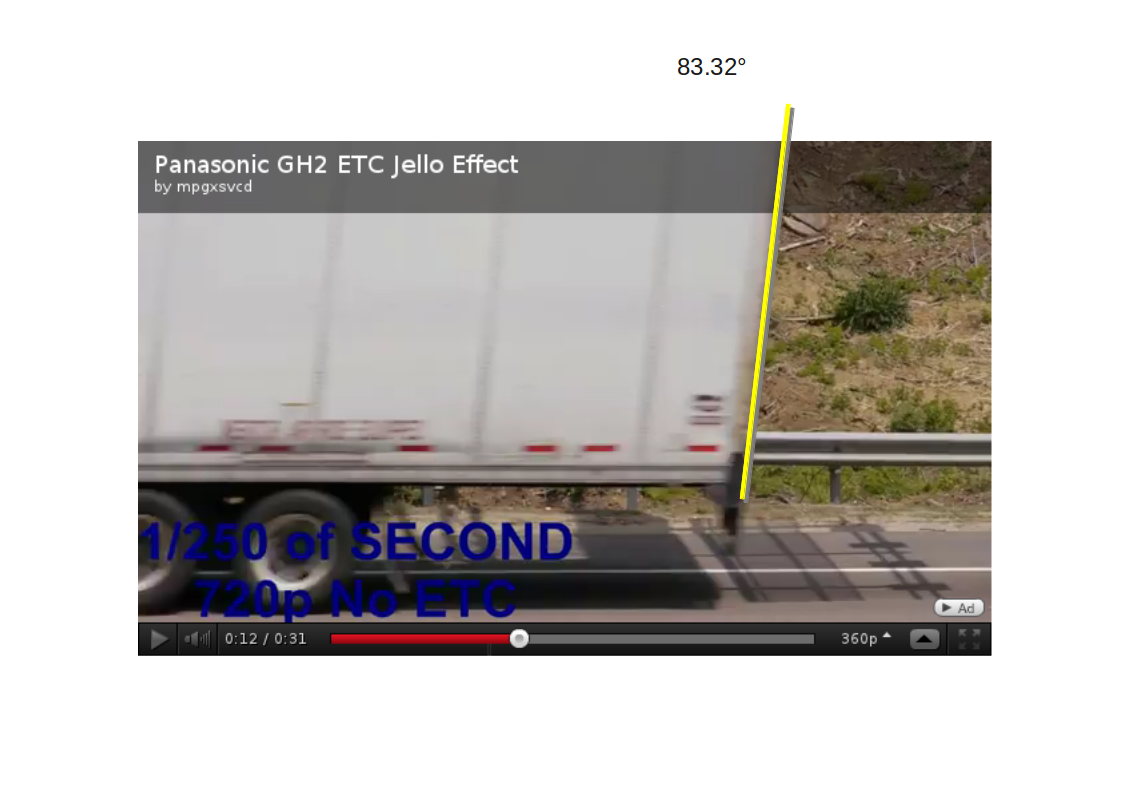
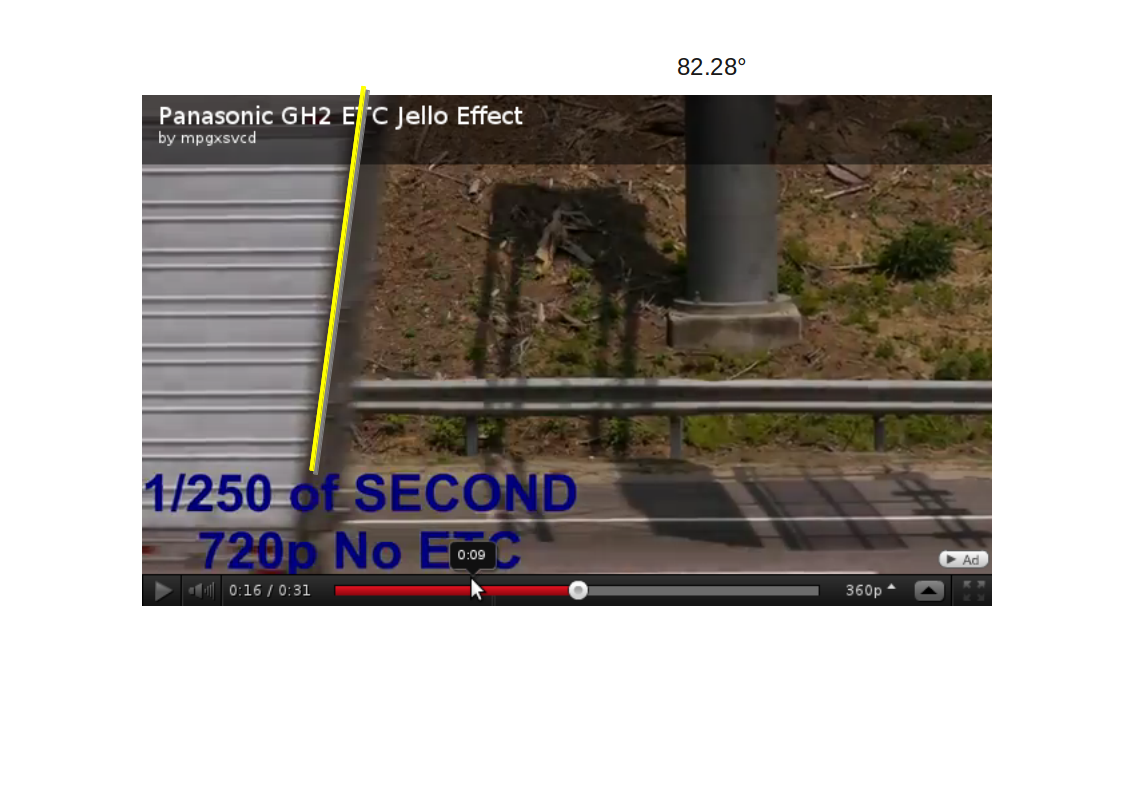
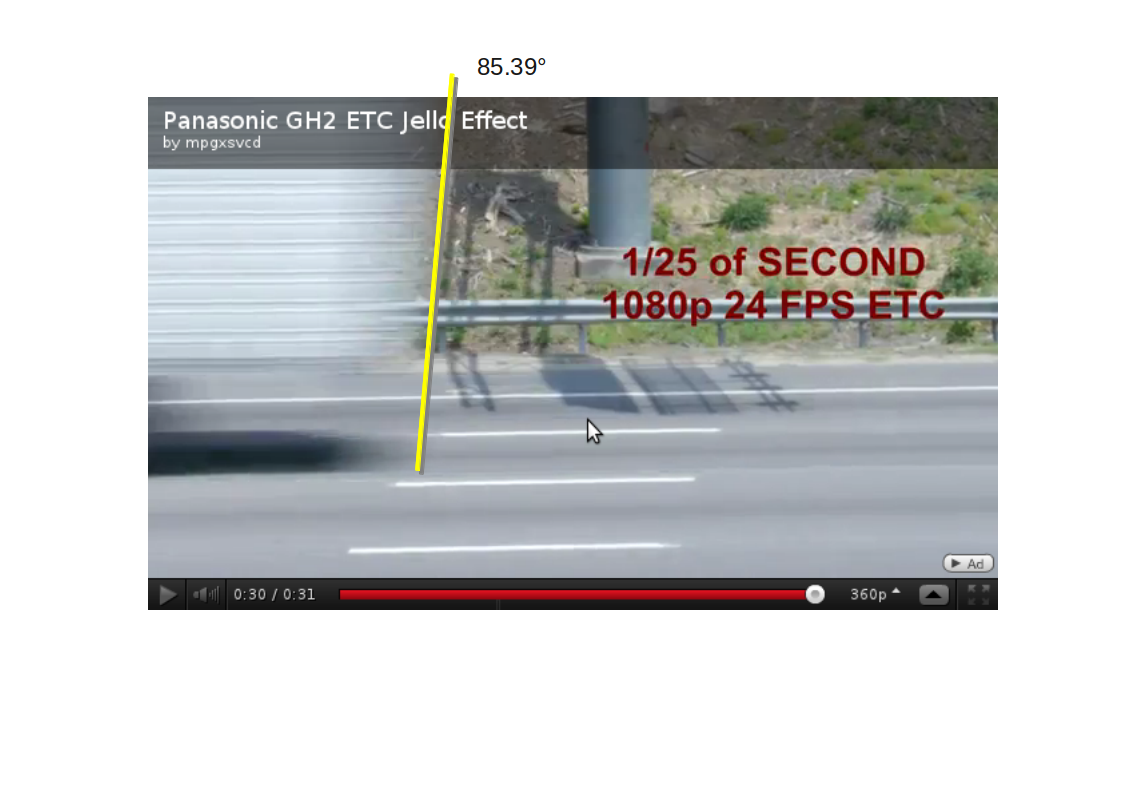
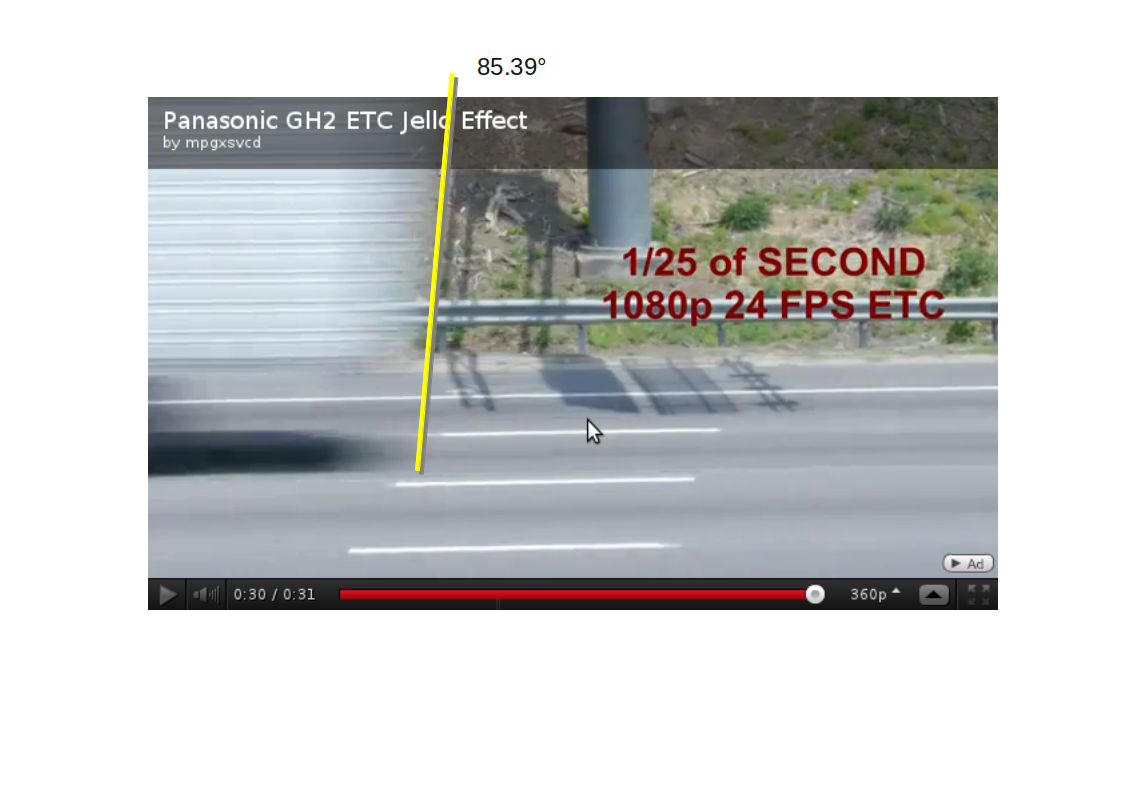

 etc720_1.PNG1123 x 794 - 444K
etc720_1.PNG1123 x 794 - 444K
 NOetc720_1.PNG1123 x 794 - 487K
NOetc720_1.PNG1123 x 794 - 487K
 NOetc720_2.PNG1123 x 794 - 445K
NOetc720_2.PNG1123 x 794 - 445K
 NOetc720_3.PNG1123 x 794 - 599K
NOetc720_3.PNG1123 x 794 - 599K
 ETC1080_2.PNG1123 x 794 - 466K
ETC1080_2.PNG1123 x 794 - 466K
 ETC1080_3.PNG1123 x 794 - 466K
ETC1080_3.PNG1123 x 794 - 466K -
@mpgxsvcd Snap! We were working on the same idea at the same time! Way to go!
[Edit] Having independently worked on the same photos before seeing your findings, I think we came to the same conclusion. I think we could hand this over for the scientific community to discuss while we move on to a metronome test. [Personally I feel like we've done this thing to death]
-
http://www.thefoundry.co.uk/products/rollingshutter/training/ Here you go. Does a short shutter really affect jello? I am not so sure about that.
-
Interesting discussion. I imagine the sensor read speed it linked to shutter speed, in which case you'd (theoretically) have identical "slants" in both normal and ETC. That's assuming 1/50 in normal is exactly the same exposure as 1/50 in ETC, which may or may not be the case (slight variances maybe, I've not done tests).
Easiest way to settle this; someone with two cameras and both kit lenses, set one to 39mm, one to 140mm. That would have pretty much the same shot. Mount one above the other on a tripod with a bit of wood and do some pans across clear vertical lines (buildings). Put one atop the other and we'll have the answer.
-
Shutter speed does not affect rolling shutter. The sensor readout “TIME” is the "ONLY" thing that affects the rolling shutter. The sensor readout speed never actually changes for a given frame rate in the GH2. The only thing that could change is the duration it takes to read out the sensor. If you are reading fewer pixels then it “COULD” take less time to read the sensor.
It appears that with the 24 FPS mode the time it takes to read the sensor does differ from what is used in the 60 FPS mode. I am only guessing here but that could mean that they use a slower readout speed in the 24 FPS mode than in the 60 FPS mode.
The time it takes to read the sensor in 60 FPS mode might be so short that the difference between reading a cropped sensor and reading the full sensor is insignificant. In 24 FPS mode it might be reading the sensor much slower than 120 FPS. Therefore cropping the sensor might have a significant impact on the total time that it takes to read the sensor.
The time it takes the rolling shutter to get from the first pixel to the last pixel is less than twice the time it takes for 1 frame to display on the highest frame rate mode(1/60th of a second). Otherwise it wouldn’t be able to be able to get through exposing and blocking every pixel on the sensor with the 720p @ 60 FPS mode.
If you look at the 1/4000th of a second still frames that I posted above you will see that there is no smearing of the image due to shutter duration. Therefore, the time it takes for the rolling shutter to complete a sweep of the whole sensor must be greater than 1/4000th of a second. Otherwise you wouldn’t see any rolling shutter affect at all because the sensor would finish reading before the object moved.
This means that the rolling shutter takes between 1/120th of a second and 1/4000th of a second. And that makes sense. Panasonic has stated that the camera has a sensor readout of 120 fps. We can only assume that they mean the sensor can expose and block the exposure for the sensor in 1/120th of a second or less. If that is accurate then it is probably reading from the first pixel to the last pixel in about 1/250th of a second or less.
That also makes sense because the horizontal skew in my 1/250th of a second picture matches the horizontal smearing in that same picture. Like I stated before, the time it takes the rolling shutter to read from top to bottom must be at least as long as it takes an exposure to show smearing of the same magnitude.
For exposures shorter than the duration of 1 frame the sensor can expose the pixels and close them off in the time it takes a frame to display or less(1/60th for 60 FPS, 1/30th for 30 FPS, 1/24th for 24p). For those shorter exposures it will simply take the full exposure and then wait until it needs to start the exposure for the next frame. Therefore, decreasing the shutter duration is not affecting the sensor readout speed at all.
If the shutter speed duration exceeds the time it takes to display 1 frame the camera must decrease the frame rate in order to allow the longer exposures. You can see this when filming in 720p @ 60 FPS. Start filming at 1/120th of a second and increase the shutter duration as you film. Once you pass 1/60th of a second(perhaps even 1/80th) you will see the affective frame rate start to decrease.
Since the camera cannot shoot at frame rates that take less time per frame than it takes to expose the full sensor, shutter speed is irrelevant in determining the rolling shutter affect. Yes if you increase the shutter duration past the time of one frame it could increase the rolling shutter affect. However, that is also decreasing the frame rate which is really why the rolling shutter affect has been increased.
-
You specified strict guidelines for how to make the cameras exactly the same. Then you just said “and do some pans”. That is the biggest issue with testing this. If you do not have absolutely consistent motion you cannot really draw a conclusion here.
Heck, even my tests should not be totally conclusive. I used as close to consistent motion as I could get. However, I had no way of guaranteeing that the speeds were the same for the trucks. That is the best I could do though. And no one else appears to be willing to try it.
Panning is not the best way to test this. Panning is a very small displacement over a short period of time. That is very hard to control without an automated rig. It is much easier to fix the camera/cameras in place and then have the subjects move in a constant and repeatable speed and motion.
-
@mpgxsvcd as long as the cameras are mounted vertically on top of each other, a pan would suffice to test the differences. It does require two cameras of course, and probably a bit of DIY to build a mount.
-
Ok sorry. I see what you are saying now. Yes attaching them together would work. Again, sorry I did not read your original post careful enough.
Howdy, Stranger!
It looks like you're new here. If you want to get involved, click one of these buttons!
Categories
- Topics List23,991
- Blog5,725
- General and News1,353
- Hacks and Patches1,153
- ↳ Top Settings33
- ↳ Beginners256
- ↳ Archives402
- ↳ Hacks News and Development56
- Cameras2,367
- ↳ Panasonic995
- ↳ Canon118
- ↳ Sony156
- ↳ Nikon96
- ↳ Pentax and Samsung70
- ↳ Olympus and Fujifilm101
- ↳ Compacts and Camcorders300
- ↳ Smartphones for video97
- ↳ Pro Video Cameras191
- ↳ BlackMagic and other raw cameras116
- Skill1,960
- ↳ Business and distribution66
- ↳ Preparation, scripts and legal38
- ↳ Art149
- ↳ Import, Convert, Exporting291
- ↳ Editors191
- ↳ Effects and stunts115
- ↳ Color grading197
- ↳ Sound and Music280
- ↳ Lighting96
- ↳ Software and storage tips266
- Gear5,420
- ↳ Filters, Adapters, Matte boxes344
- ↳ Lenses1,582
- ↳ Follow focus and gears93
- ↳ Sound499
- ↳ Lighting gear314
- ↳ Camera movement230
- ↳ Gimbals and copters302
- ↳ Rigs and related stuff273
- ↳ Power solutions83
- ↳ Monitors and viewfinders340
- ↳ Tripods and fluid heads139
- ↳ Storage286
- ↳ Computers and studio gear560
- ↳ VR and 3D248
- Showcase1,859
- Marketplace2,834
- Offtopic1,320










